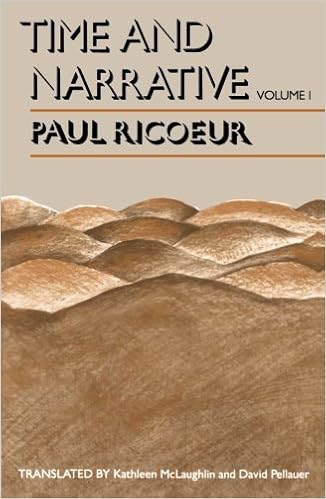
By Paul Ricoeur
Ricoeur unearths a "healthy circle" among time and narrative: time is humanized to the level that it portrays temporal adventure. Ricoeur proposes a theoretical version of this circle utilizing Augustine's idea of time and Aristotle's concept of plot and, extra, develops an unique thesis of the mimetic functionality of narrative. He concludes with a finished survey and critique of recent discussions of ancient wisdom, realizing, and writing from Aron and Mandelbaum within the overdue Nineteen Thirties to the paintings of the Annales tuition and that of Anglophone philosophers of historical past of the Nineteen Sixties and 1970s.
"This paintings, in my opinion, places the complete challenge of narrative, let alone philosophy of heritage, on a brand new and better airplane of discussion."—Hayden White, History and idea
"Superb. . . . an exceptional aspect of front into the paintings of 1 of the eminent thinkers of the current highbrow age."—Joseph R. Gusfield, Contemporary Sociology
Read or Download Time and Narrative, Volume 1 (Time & Narrative) PDF
Best Phenomenology books
Phenomenology, including Marxism, pragmatism, and analytic philosophy, ruled philosophy within the 20th century—and Edmund Husserl is generally notion to were the 1st to enhance the idea that. His perspectives encouraged numerous very important later thinkers, resembling Heidegger and Merleau-Ponty, who ultimately grew to become phenomenology clear of questions of information.
The philosophical paintings of Jean-Luc Marion has opened new methods of talking approximately non secular convictions and reports. during this exploration of Marion’s philosophy and theology, Christina M. Gschwandtner offers a complete and demanding research of the tips of saturated phenomena and the phenomenology of givenness.
The New Science of the Mind: From Extended Mind to Embodied Phenomenology (Bradford Books)
There's a new frame of mind in regards to the brain that doesn't find psychological approaches solely "in the top. " a few imagine that this accelerated perception of the brain would be the foundation of a brand new technological know-how of the brain. during this booklet, top thinker Mark Rowlands investigates the conceptual foundations of this new technological know-how of the brain.
Extra info for Time and Narrative, Volume 1 (Time & Narrative)
So the choice to write down has the skill to transpose the extratemporal personality of the unique imaginative and prescient into the temporality of the resurrection of time misplaced. during this experience we may well say, in all fact, that Proust’s paintings narrates the transition from one which means of time regained to the opposite; and it truly is as a result that it's a story approximately time. It continues to be to assert in what method the narrative personality of the beginning of a vocation is guaranteed by means of the act of checking out that follows the revelation of the reality of artwork in addition to via the hero’s involvement within the paintings to be complete. This trying out takes during the problem of loss of life. it's not an overstatement to assert that it's the relation to loss of life that makes the adaptation among the 2 meanings of time regained: the extratemporal, which transcends “my anxiousness with reference to my demise” and makes me “unalarmed by way of the vicissitudes of the long run” (III, p. 904), and the resurrection within the paintings of misplaced time. If the destiny of the latter is ultimately passed over to the exertions of writing, the specter of dying isn't any much less in time regained than in time misplaced. ninety three this is often what the narrator intended to point by means of having the narrative of the conversion to writing via the superb spectacle provided through the visitors on the Prince de Guermantes’s ceremonial dinner. This dinner, the place the entire site visitors looked as if it would have “put on a cover [s’être fait une tête’]” (III, p. 920)—actually, a death’s head—is expressly interpreted via the narrator as a “spectacular and dramatic impression” (III, p. 959), which he says, “threatened to elevate opposed to my company the gravest of all objections” (III, p. 959–60). what's this, if no longer the reminder of demise, which, with none carry at the extratemporal, threatens its temporal expression, the murals itself. who're the characters during this dance of dying? “A puppet-show, certain, yet one during which, with a view to determine the puppets with the folks whom one had identified some time past, it used to be essential to learn what was once written on numerous planes instantaneously, planes that lay in the back of the obvious point of the puppets and gave them intensity and compelled one, as one checked out those elderly marionettes, to make a strenuous highbrow attempt; one used to be obliged to review them while with one’s eyes and with one’s reminiscence. those have been puppets bathed within the immaterial colors of the years, puppets which exteriorized Time, Time which via behavior is made invisible and to come into sight seeks our bodies, which anywhere it reveals it seizes, to show its magic lantern upon them” (III, p. 964). ninety four And what do a majority of these moribund figures announce, if no longer the hero’s personal coming near near demise? (III, p. 967). right here lies the risk. “I had made the invention of this damaging motion of Time on the very second whilst I had conceived the ambition to make noticeable, to intellectualize in a piece of paintings, realities that have been outdoor Time” (III, p. 971). This admission is of substantial value. will possibly not the previous fantasy of damaging time be more desirable than the imaginative and prescient of time regained in the course of the murals?



